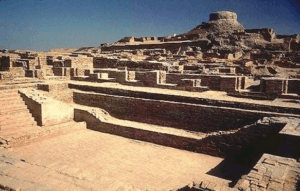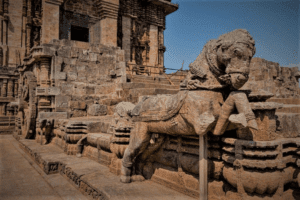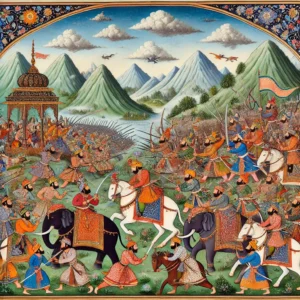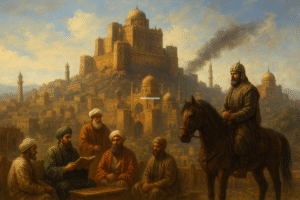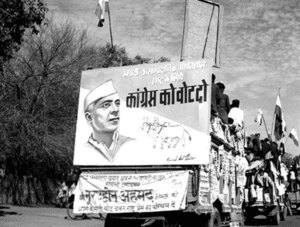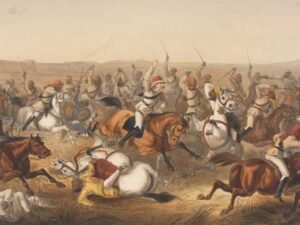🏛️ Introduction
The Roman Empire was a titan of antiquity—a vast dominion that shaped the political, architectural, cultural, and economic destiny of Europe and the Mediterranean world. Spanning continents, connecting civilizations, and influencing global history, Rome is often seen as the benchmark for imperial grandeur.
But what was the Roman equivalent in ancient India?
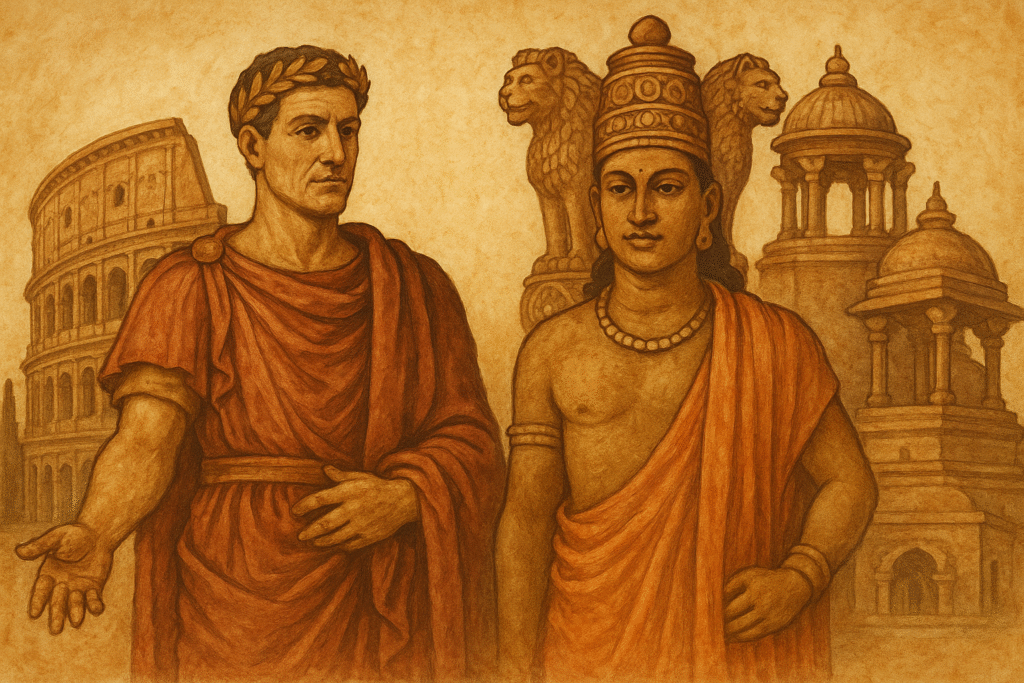
This question doesn’t have a single answer. Instead, various Indian empires and kingdoms—each rising in different epochs and regions—reflected Rome’s many facets. Whether it’s the administrative precision of the Mauryas, the cultural brilliance of the Guptas, the maritime trade of the Tamil kingdoms, or the cosmopolitan frontier energy of the Kushan Empire, India had its own civilizational giants that paralleled Rome in scale, sophistication, and influence.
Let’s journey through the Indian subcontinent to uncover its Roman counterparts.
I. Maurya Empire (322–185 BCE): The Indian Superstate
Comparable to: Early Imperial Rome under Augustus and his successors
Key Figures: Chandragupta Maurya, Bindusara, Ashoka the Great
Capital: Pataliputra (modern Patna)
The Maurya Empire, established shortly after Alexander’s retreat from India, was the first political entity to unify nearly the entire Indian subcontinent. Under Chandragupta Maurya, and later his grandson Ashoka, the empire expanded to encompass present-day Afghanistan, Pakistan, most of India (except parts of the far south), and even into modern-day Bangladesh and Nepal.
Much like Rome:
- The Mauryas had a centralized bureaucracy, including ministries for taxation, espionage, and trade.
- The empire was governed through a network of provincial governors, much like Roman provinces under imperial legates.
- Their roads, rest houses, and imperial communications rival the famed Roman roads in strategic importance.
- Under Ashoka, a spiritual transformation took place—just as Constantine would later Christianize the Roman Empire, Ashoka embraced Buddhism and promoted a moral, non-violent vision of governance through his rock edicts inscribed across South Asia.
This was India’s first attempt at a true empire, with a vision of ethical statecraft, infrastructural unity, and pan-subcontinental rule. If Rome was the epitome of imperial authority in the West, the Mauryas were its reflection in the East.
II. Gupta Empire (320–550 CE): India’s Classical Age
Comparable to: High Empire Rome (1st–2nd century CE, Pax Romana)
Key Figures: Chandragupta I, Samudragupta, Chandragupta II
Capital: Pataliputra, Ujjain
If the Mauryas were India’s Augustus, the Guptas were its Hadrian and Marcus Aurelius—a time of prosperity, stability, and a flowering of arts and science. The Gupta era is often referred to as the Golden Age of India.
In this era:
- Literature, particularly in Sanskrit, flourished through figures like Kalidasa.
- Mathematics and astronomy advanced significantly—Aryabhata proposed the rotation of the Earth and the concept of zero emerged.
- Temple architecture evolved with majestic stone temples, elaborate carvings, and decorative art akin to Rome’s own architectural feats.
- Gupta coinage and inscriptions reflected both wealth and a sense of divine kingship.
Like the Pax Romana, the Gupta period witnessed peace, economic development, and cultural integration. It was an era when Indian civilization shined across Asia, influencing regions as far as Southeast Asia and China.
III. Tamil Kingdoms & Indo-Roman Trade: The Indian Mediterranean
Comparable to: Rome’s maritime provinces and trading partners
Key Regions: Chola, Pandya, Chera kingdoms
Key Ports: Muziris, Arikamedu, Kaveripattinam, Puhar
From the 1st century BCE to the 3rd century CE, southern India maintained flourishing maritime trade with the Roman world.
Roman coins, amphorae, glassware, and ceramics have been found in abundance in Tamil Nadu and Kerala, particularly at archaeological sites like Arikamedu and Pattanam. The Roman historian Pliny the Elder even lamented the empire’s growing trade deficit with India, claiming that Rome was being drained of gold by its eastern imports.
The Tamil Sangam literature of the period speaks of Yavanas (foreigners, including Greeks and Romans) arriving at bustling ports with ships full of wine and treasure, trading for Indian pepper, pearls, textiles, and ivory.
This interaction was not one-sided:
- Indian goods reached Roman elite households.
- Roman aesthetics influenced some local art forms.
- Southern Indian kingdoms grew wealthy and powerful through this Indo-Roman maritime economy.
If Rome was the anchor of the Mediterranean, Tamilakam was its eastern mirror—a maritime crossroads of luxury, culture, and commerce.
IV. Kushan Empire (1st–3rd Century CE): India’s Multicultural Frontier
Comparable to: Rome’s eastern provinces (like Syria, Egypt, or Asia Minor)
Key Figures: Kanishka the Great
Capital: Purushapura (Peshawar), Mathura
The Kushans emerged from Central Asia and established an empire that stretched from Uzbekistan and Afghanistan into northern India.
Their reign was defined by:
- Cosmopolitanism: The Kushan realm was a melting pot of Indian, Greek, Persian, and Central Asian cultures.
- Religious diversity: They patronized Buddhism (especially Mahayana), Shaivism, Zoroastrianism, and local cults.
- Greco-Buddhist art: Particularly in Gandhara, where Roman-style drapery and Greek realism fused with Buddhist themes to create an entirely new artistic tradition.
- Strategic location: Sitting on the Silk Road, the Kushans controlled overland trade between Rome, Persia, China, and India.
- Their coinage, featuring both Indian and Greco-Roman deities, echoed Rome’s religious syncretism.
Like Rome’s provinces in the Levant and Anatolia, the Kushan Empire was a frontier civilization, absorbing and transmitting cultural energies across Eurasia.
Comparative Overview
| Roman Feature | Indian Equivalent(s) | Description |
|---|---|---|
| Centralized Empire | Maurya Empire | Strong bureaucracy, pan-Indian rule |
| Cultural Renaissance | Gupta Empire | Flourishing of art, science, literature |
| International Trade Hub | Tamil Kingdoms, Satavahanas | Active Indo-Roman maritime trade |
| Cosmopolitan Border Empire | Kushan Empire | Greco-Buddhist fusion, Silk Road dominance |
| Urban & Economic Sophistication | All of the above, especially Gupta & South India | Cities like Pataliputra, Ujjain, Arikamedu mirrored Roman urban life |
The Indian World and the Roman World
There was no single Indian “Rome”—but multiple Indian empires captured different aspects of Roman greatness.
- The Mauryas paralleled Rome’s political and military unity.
- The Guptas mirrored its cultural brilliance and intellectual golden age.
- The Tamils and Satavahanas were India’s answer to Roman trade empires.
- The Kushans shared its multicultural frontier energy and international reach.
Together, these powers made the Indian subcontinent a civilization of comparable complexity, global engagement, and imperial ambition.
So when we ask, “What was the Roman Empire’s equivalent in India?”, the answer is not singular—it’s civilizational. It is the collective story of India’s great empires that formed the eastern mirror of the ancient world.
📚 Further Reading:
- Romila Thapar – Ashoka and the Decline of the Mauryas
- Upinder Singh – A History of Ancient and Early Medieval India
- K.A. Nilakanta Sastri – The Cholas
- Himanshu Prabha Ray – The Archaeology of Seafaring in Ancient South Asia

